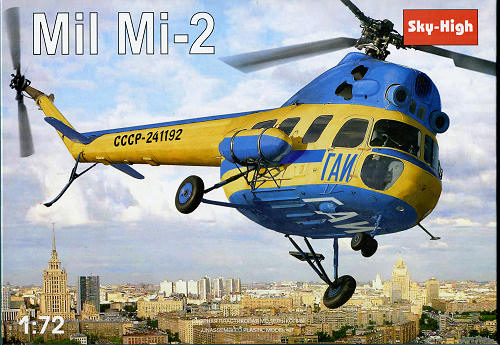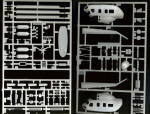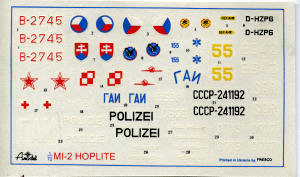
Sky-High 1/72 Mil Mi-2
| KIT #: | 7226 |
| PRICE: | $10.45 at www.scale-model-kits.com |
| DECALS: | Eight options |
| REVIEWER: | Scott Van Aken |
| NOTES: |

| HISTORY |
The Mi-2 was produced exclusively in Poland, in the WSK "PZL-Świdnik" factory in Świdnik. Production ended in 1985 after about 7,200 were made.
The first production helicopter in the Soviet Union was the Mil Mi-1, modelled along the lines of the S-51 and Bristol Sycamore and flown by Mikhail Mil's bureau in September 1948. During the 1950s it became evident, and confirmed by American and French development, that helicopters could be greatly improved with turbine engines. S. P. Isotov developed the GTD-350 engine and Mil used two of these in the far superior Mi-2. After initial development at the Mil bureau (Soviet designation V-2) this was transferred to Poland in 1964, after the first Swidnik-built example had flown. WSK-Świdnik has since delivered many hundreds, possibly one-third of them to military customers, and developed plastic rotor blades and the wide-body Mi-2M seating 10 passengers instead of eight. Most typical role kits include four stretchers, as air ambulance, or aerospraying or cropdusting device.
In Poland, there were also developed several specialized military variants, first of all support or reconnaissance ones, with 23 mm autocannon, machine guns and/or two 57 mm rocket pods, four 9K11 Malyutka anti-tank missiles or Strela-2 AA missiles.
It was first introduced into the Soviet Air Force in 1965. The Mi-2 is used by mainly former Soviet and Eastern Bloc countries, although it is used by Mexico and Myanmar as well.
Most of armed Mi-2 variants were used by Poland. Some were also used by the East Germany (with machine gun and unguided rocket armament only).
North Korea still maintains a large active fleet of Mi-2s. In the event of a war with the ROK, the primary mission of the 200+ aircraft would be the insertion of nK SOF forces behind enemy lines. These SOF forces would be tasked with opening the "second front" against the allied forces, in order to disrupt their ability to counter the nK invasion. The life-expectancy for the Mi-2s would be short, and many would likely not return from their initial mission.
| THE KIT |
 You know, one has to be pretty amazed at how much the model kit business in Ukraine has grown in the last 20 years or so. Basically from nothing to being one of the more prolific producers of model kits in the world. While many will point to the Czech Republic as a better example, the truth is that the Czechs already had a head start as they were producing nice kits even before the end of the Cold War.
You know, one has to be pretty amazed at how much the model kit business in Ukraine has grown in the last 20 years or so. Basically from nothing to being one of the more prolific producers of model kits in the world. While many will point to the Czech Republic as a better example, the truth is that the Czechs already had a head start as they were producing nice kits even before the end of the Cold War.
This kit is from another company that is new to me, Sky-High. This particular subject is something one could easily call the 'Soviet Huey' as it was built in huge numbers and served with pretty much every Warsaw Pact country and a few more. Molded on two white sprues and one clear, the molding is actually very good. I found almost no flash, no prominent ejector pin marks and a sink area on but a couple of parts. Even the standard mold lines were not very prominent. The slightly pebbly surface of the plastic is something common with a number of kit makers and disappears under paint.
Though I've not shown the clear sprue, the plastic is pretty clear and something I like is that all the individual windows have small tabs on them to keep them from popping through the holes for them. Though the instructions show these as being inserted from the outside, I'm wondering if they wouldn't fit equally as well (in most cases) from the interior. Speaking of which, the interior is pretty basic. There is no bulkhead between the cockpit and cabin. In the cabin are one set of fore/aft seats. The cockpit has but a pair of seats and a single cyclic control. No collective and not rudder pedals. There is an instrument panel but it has no detail, no decal and a large sink area in it. This one will need ten grams of weight to not sit on its tail.
The fuselage is made from four parts. The tail boom is separate from the rest of the fuselage. I'm not sure if this is due to the inability to mold it or if it allows for alternate variants. There are 103 pieces in this kit so it is not a slap together. The rotor head appears to be detailed enough for most. The blades have no droop in them so you'll have to add that if you wish. There are a few options in terms of what the helo can carry. There is a cannon to fit on the lower portion of the fuselage and on the side one can install fuel tanks, rocket pods or air to ground missiles.
 One thing that is offered are a lot of markings options. There is the box art helo from the GAI of the Soviet Union (I'm assuming those are border guards), a German Police helo from the 1980s, a Czech version from the 28th Fighter Bomber regiment in 1994, a Slovak version from the same time period, a 1980s Polish version, a Czech police version from 1994, a Russian one from the 1980s and Czech SAR bird from 1995. Most of these are quite colorfully or complexly marked, so the painter will have some fun with this one. Decals are quite matte, pretty well done and have very large carrier film over each one. Instructions are well done and provide Humbrol paint references.
One thing that is offered are a lot of markings options. There is the box art helo from the GAI of the Soviet Union (I'm assuming those are border guards), a German Police helo from the 1980s, a Czech version from the 28th Fighter Bomber regiment in 1994, a Slovak version from the same time period, a 1980s Polish version, a Czech police version from 1994, a Russian one from the 1980s and Czech SAR bird from 1995. Most of these are quite colorfully or complexly marked, so the painter will have some fun with this one. Decals are quite matte, pretty well done and have very large carrier film over each one. Instructions are well done and provide Humbrol paint references.
| CONCLUSIONS |
Nice to see a model of this important Warsaw Pact helo. I'm sure those with large decal stashes and good references will be able to model something aside from what the kit offers. One thing for sure, you won't have to break the bank to buy this one.
| REFERENCES |
July 2010
Thanks to www.scale-model-kits.com for the preview kit. Get yours at the link and at a discount. If you would like your product reviewed fairly and fairly quickly, please contact the editor or see other details in the Note to Contributors.